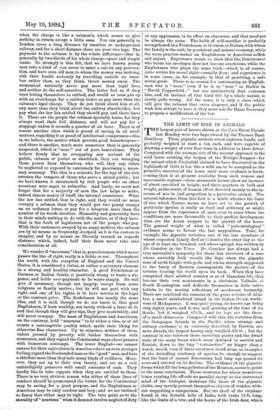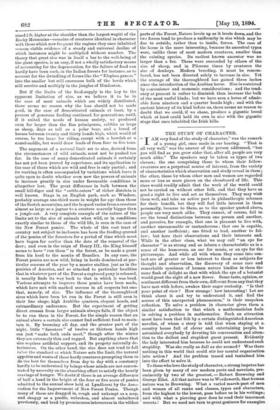THE LIMIT OF SIZE IN ANIMALS.
THE largest pair of horses shown at the Cart-Horse Parade last Monday were two bays owned by the Thames Bank Distillery. These gigantic animals stood eighteen hands, and probably weighed at least a ton each, and were capable of drawing a weight of over four tons, in addition to their driver. Compared with the average size of the nearest approach to the wild horse existing, the tarpan of the Khirgiz Steppes—for the animal which Prejvalski claimed to have discovered in the highlands of Gobi is too like a wild ass to be accepted as the primitive ancestor of the horse until more evidence is forth- coming than is at present available from such remote and inaccessible regions—these mammoth horses show an increase of about one-third in height, and three-quarters in bulk and weight, as the result of human effort directed mainly to the in- crease of size in just proportion in a particular animal. The natural inference from this fact is a doubt whether the limit of size which Nature seems to have set to the growth of particular species is really as fixed and arbitrary as might appear from the experience of ages, even in cases where the conditions are more favourable to their perfect development than are the Asian steppes to the growth of the horse. The general weight of what is called " palmontological " evidence seems to favour the last supposition. Take, for example, the gigantic tortoises, one of the last members of whose respected family died at Colombo the other day at the age of at least one hundred, and whose epitaph was written by Dr. Gunther in the Times. Dr. Gunther has always had a true naturalist's sympathy for these last survivors of a race whose unwieldy balk recalls the days when the gigantic sons of earth fought with gods, and whose strength suggested to the fancy of Eastern cosmogenists the picture of the tortoise bearing the world upon its back. When they have completed their allotted century or so of blameless life, they become their own monuments in a chelonian Valhalla at South Kensington, and dedicate themselves in little votive tablets to the musing reflections of mushroom humanity. There are exhibited the remains of the great tortoise of Alda- bra, a small uninhabited island in the Indian Ocean, north- west of Madagascar. It was quite young, its known age being only eighty years, and it was still growing at the time of its death; but it weighed 870 lb., and its legs are like those of a small rhinoceros. Compared with this, the tortoises from the Galapagos Islands in the Pacific, whose strange and solitary existence is so curiously described by Darwin, are mere dwarfs, the largest having only weighed 200 lb. ; but the contrast in size between these surviving giants and the dwarf scale of the many forms which seem destined to survive and flourish, down to the tiny " tortoisettes " no bigger than a watch, would, even if these creatures stood alone as examples of the dwindling tendency of species, be enough to suggest that the limit of animal dimensions had long ago passed its acme and entered on its decline. The evidence of the gigantic forms which fill the long galleries of the Museum, seems to point to the same conclusion. Those creatures for whose monstrous bones existing life affords no parallel except to the instructed mind of the biologist, skeletons like those of the gigantic sloths, may merely present themselves objects of wonder, with- out suggesting a comparison. But the skull of the elephant found in the Sewalik hills of India, with tusks 12 ft. long, like the limbs of a tree, and the horns of the Irish deer, which
stood 2 ft. higher at the shoulder than the largest wapiti of the Rocky Mountains—remains of creatures identical in character with those which now frequent the regions they once inhabited —seem visible evidence of a steady and universal decline of which instances might be multiplied without number. The theory that great size was in itself a bar to the well-being of the giant species, is an easy, if not a wholly satisfactory means of accounting for the degeneration, for the failure of food can hardly have been such, in the Indian forests for instance, as to account for the dwindling of forms like the " Elephas ganesa " into the smaller but still enormous bulk of the herds which still survive and multiply in the jungles of Hindostan.
But if the limits of the food-supply is the key to the apparent limitation of size, as we believe it to be in the case of most animals which are widely distributed, there seems no reason why the loss should not be made good, in the case of domesticated animals at least, by a process of generous feeding continued for generations, until, if it suited the needs of human society, we produced oxen far larger than the Bos primigenus, rabbits as large as sheep, dogs as tall as a polar bear, and a breed of horses between twenty and thirty hands high, which would of course, be too large for riding, except with a howdah or a camel-saddle, but would draw loads of from four to five tons.
The argument of a natural limit set to size, derived from the circumstances of wild animals, must not be pushed too far. In the case of many domesticated animals it certainly has not yet been proved by experience, and its application to the case of those which are wild and free is only partial ; and its working is often accompanied by variations which leave it quite open to doubt whether even now the powers of animals to increase greatly in size under favourable conditions is altogether lost. The great difference in bulk between the small hill-tiger and the " cattle-eaters " of richer districts is well known. Stags in an English park, such as Windsor, probably average one-third more in weight for age than those of the Scotch mountains, and the leopard varies from a creature almost as large as a jaguar to a creature scarcely bigger than a jungle-cat. A very complete example of the nature of the limits set to the size of animals when wild, or in conditions exactly similar to those of the wild life, is seen in the case of the New Forest ponies. The whole of this vast tract of country not subject to inclosure has been the feeding-ground of the ponies of the foresters for a period of time which must have begun far earlier than the date of the removal of the deer; and even in the reign of Henry III., the King himself seems to have "run them" in the forest, as he made a grant from his herd to the monks of Beaulieu. In any case, the Forest ponies are now wild, living in herds dominated at par- ticular seasons of the year by a master stallion just as in the prairies of America, and so attached to particular localities that in whatever part of the Forest a captured pony is released, it usually finds its way back to that in which it was bred. Various attempts to improve these ponies have been made, which have met with marked success in all respects but one, that, namely, of size. The influence of the thoroughbred sires which have been let run in the Forest is still seen in their fine shape, high Arablike quarters, elegant heads, and extraordinary endurance. But the experiment of getting direct crosses from larger animals always fails, if the object be to run them in the Forest, for the simple reason that an animal above a certain size cannot find sufficient food to main- tain it. By browsing all day, and the greater part of the night, little " foresters " of twelve or thirteen hands high can just "make both ends meet," though after the winter they are extremely thin and ragged. But anything above that size requires artificial support, and its progeny naturally de- teriorates. On the other hand, the size does not tend to fall be!ow the standard at which Nature sets the limit, the natural appetite and wants of these hardy creatures prompting them to do the best for themselves from day to day with a constancy hardly to be understood by beings whose minds are not concen- trated by necessity on the absorbing effort to satisfy the hourly cravings of hunger. We doubt if there is an average difference of half a hand in the height of the four or five score of ponies admitted to the annual show held at Lyndhurst by the Asso- ciation for the Improvement of New Forest Ponies. Though many of these are dragged in, rough and unkempt as a mop, and shaggy as a poodle, unbroken, and almost unhaltered previously, and bred by promiscuous intercourse in the wildest parts of the Forest, Nature levels up as it levels down, and the two forces tend to produce a uniformity in size which may be due to outside, rather than to inside, forces. The case of the horse is the more interesting, because its ancestral types. were, unlike those of most modern creatures, smaller than the existing species. Its earliest known ancestor was no larger than a fox. These were succeeded by others of the- size of sheep, and in Pliocene times by creatures the size of donkeys. Modern breeding, it must be remem- bered, has not been directed solely to increase in size. Yet the average of the thoroughbred has gained three inches- since the introduction of the Arabian horse. Size is restricted by convenience and economic considerations ; and the tend- ency at present is rather to diminish than increase the bulk of the most useful kinds; but we have seen a horse of admir- able form nineteen and a quarter hands high ; and with the- ancient history of its kind before us, there seems no reason to- doubt that we could, if we chose, produce a gigantic breed, which at least could hold its own in size with the gigantic stags that once inhabited the Irish hills.







































 Previous page
Previous page